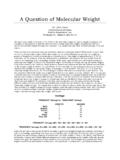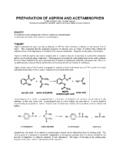Transcription of Vapor Pressure and Colligative Properties
1 Science Enhanced Scope and Sequence Chemistry Vapor Pressure and Colligative Properties Strand Phases of Matter and Kinetic Molecular Theory Topic Investigating kinetic theory Primary SOL The student will investigate and understand that chemical quantities are based on molar relationships. Key concepts include a) Avogadro's principle and molar volume;. b) stoichiometric relationships;. c) solution concentrations;. d) acid/base theory; strong electrolytes, weak electrolytes, and nonelectrolytes; dissociation and ionization; pH and pOH; and the titration process.
2 The student will investigate and understand that the phases of matter are explained by kinetic theory and forces of attraction between particles. Key concepts include a) Pressure , temperature, and volume;. b) partial Pressure and gas laws;. c) Vapor Pressure ;. d) phase changes;. e) molar heats of fusion and vaporization;. f) specific heat capacity;. g) Colligative Properties . Related SOL The student will investigate and understand that experiments in which variables are measured, analyzed, and evaluated produce observations and verifiable data. Key concepts include a) designated laboratory techniques.
3 B) safe use of chemicals and equipment;. c) proper response to emergency situations;. e) accurate recording, organization, and analysis of data through repeated trials;. g) mathematical manipulations including SI units, scientific notation, linear equations, graphing, ratio and proportion, significant digits, and dimensional analysis;. h) use of appropriate technology including computers, graphing calculators, and probeware for gathering data, communicating results, and using simulations to model concepts. Background Information Before undertaking this activity, students should have a basic understanding of ionic versus covalent bonding, molarity, basic kinetics, and solubility.
4 This lesson will focus on the conceptual understanding of the influence of intermolecular forces on the magnitude of the Vapor Pressure of a liquid, the determination of the normal boiling point of a substance, and the effect of solute virginia department of education 2012 1. Science Enhanced Scope and Sequence Chemistry particles on the Vapor Pressure of a solution and the Colligative Properties that occur as a result of their presence. Reviewing the concepts of polarity, dissociation, and like dissolves like is recommended. Students should be familiar with the units of temperature and Pressure and the conversions between them.
5 Most of the activities are fairly straightforward; however, the evaporation-rate investigation is somewhat open-ended. For classes that need more structure, you might want to decide which procedure they should do, while for stronger classes, you may want to give them some choices. Classes that need less structure might design their own procedures within given parameters of the materials available. If temperature probes are available, students will find it extremely interesting to see the evaporation-rate effect graphically as evaporative cooling versus time.
6 CAUTION! Keep procedures as much on a microscale as possible to reduce fumes. Some options for measuring evaporation rate are the following: If you have electronic balances, measure loss of mass versus time directly. With timers, measure the time it takes for a drop to evaporate, doing repeated trials and averaging the results. With temperature probes, dip them in the liquid and then remove them, graphing temperature versus time. This allows the measurement of the time needed to evaporate (return to room temperature), and it allows students to see that more volatile liquids have a greater cooling effect when evaporating.
7 The molecular mass of hexane is too high to be used in this comparison. Pentane is fairly inexpensive and as safe as hexane to use, but you should still exercise caution. Butane (lighter fluid) could be used in place of pentane, but it is a greater fire risk and evaporates so quickly that only spot testing is an option. Materials Note: Materials will depend on the method(s) chosen for determining evaporation rate. Liquids: water, ethanol, acetone, pentane Solids: NaCl, sugar, wax (paraffin). NaCl solution (350 g/L). Sugar solution (350 g/L). Spotting plates or watch glasses Hot plates Beakers Erlenmeyer flask with stopper Thermometers or temperature probes Balances Timers Vacuum pump Toothpicks Attached worksheets Vapor Pressure Versus Temperature, and Vapor Pressure and Intermolecular Forces virginia department of education 2012 2.
8 Science Enhanced Scope and Sequence Chemistry Student/Teacher Actions (what students and teachers should be doing to facilitate learning). Introduction 1. Start this lesson by having students diagram the molecules of the target liquids and identify their dominant intermolecular force. 2. Have students predict the relative magnitude of the intermolecular forces from weakest to strongest by having them complete the attached Vapor Pressure and Intermolecular Forces worksheet. 3. Define Vapor Pressure , and discuss its relationship to intermolecular forces. Along with this discussion, either demonstrate Vapor Pressure or use a computer simulation of it (see Resources, if you do not have one), showing how it is affected by temperature.
9 For example, if you have a temperature probe, insert it into a one-hole stopper that fits an Erlenmeyer flask containing a small amount of water. Seal the flask, and start recording temperature versus time as you gently warm the flask so students can see the Pressure increase as the temperature increases. 4. Ask students at what temperature water boils. Then ask them whether all substances that are liquid at room temperature boil at this temperature. Ask them whether water always boils at this temperature. Have them explain their reasoning. 5. Demonstrate water boiling at different temperatures.
10 Place 100 mL of water into each of three small beakers, and label them 50 C, 65 C, and 80 C. Raise the temperature of the water in each beaker to the labeled temperature. Have a student check the temperatures, which do not need to be exactly the labeled temperatures, and record the measured values. Place all three beakers on the plate of the vacuum pump, seat the lid, and turn on the pump. Ask students to watch and record the order in which they boil as the Pressure decreases. 6. Release the vacuum, and discuss the relationship between air Pressure and boiling point.

















